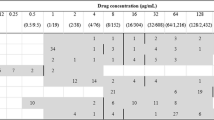Abstract
The occurrence of trimethoprim (Tp) resistance in salmonellas isolated from humans and water samples in Sicily between 1985 and 1988 has been investigated and the Tp resistance mechanisms have been further characterized on the basis of hybridization with probes for the dihydrofolate reductase (DHFR) genes types I, II, IV and V. Of 765 strains examined, high level (>1000 mg/1) resistance to Tp was identified in 23 strains (3%). In 22 of these strains, such resistance was associated with resistance to sulphonamides. Six serovars with Tp-resistant strains were identified,Salmonella typhimurium (14 strains),S. enteritidis (2),S. agona (2),S. mbandaka (2),S. virchow (2),S. Indiana (1). In all strains with high level Tp resistance, resistance to this antimicrobial was plasmid-encoded, in most strains by plasmids with MWs ranging from 70–100 MDa. On the basis of restriction endonuclease analysis, four different categories of Tp resistance plasmids were identified in Tp-resistant strains ofS. typhimurium. Hybridization with the DHFR I probe was observed in three strains of Tp-resistantS. typhimurium and two strains of Tp-resistantS. enteritidis; in contrast, in none of the strains tested was there any detectable hybridization with the probes for DHFR types II, IV and V. It is concluded that the DHFR type I resistance mechanism, common in Tp-resistant enterobacteria in many European countries, is relatively uncommon in Tp-resistant salmonellas isolated in Sicily. Furthermore, the DHFR V resistance mechanism, previously identified in strains ofShigella sonnei isolated in Sicily and associated with travellers from Sri Lanka, has not yet appeared in salmonellas in Sicily.
Similar content being viewed by others
References
Fleming MP, Datta N, Gruneberg RN. Trimethoprim resistance determined by R-factors. Br Med J 1974 (i): 726–728.
Lacey RW, Gillespie WA, Bruten DM, Lewis E. Trimethoprim-resistant coliforms. Lancet 1972 (i): 409–410.
Fleming MP. Trimethoprim resistance and its transferability inE. coli isolated from calves treated with trimethoprim-sulphadiazine: A two year study. J Hyg (Camb) 1973; 71: 669–677.
Richards H, Datta N, Wray C, Soika WJ. Trimethoprim resistance plasmids and transposons inSalmonella. Lancet 1978 (ii): 1194–1196.
Ward LR, Rowe B, Threlfall EJ. Incidence of trimethoprim resistance in salmonellae isolated in Britain: A twelve year study. Lancet 1982 (ii): 705–706.
Amyes SGB. The success of plasmid-encoded resistance genes in clinical bacteria. J Med Microbiol 1989; 28: 73–83.
Goldstein FW, Papadopoulou B, Acar JF. The changing pattern of trimethoprim resistance in Paris with a review of worldwide experience. Rev Infect Dis 1986; 8: 725–737.
Grant RB, Bannatyne RM, Shipley AJ. Resistance to chloramphenicol and ampicillin inSalmonella typhimurium in Ontario, Canada. J Infect Dis 1976; 134: 354–361.
Hedges RW, Datta N, Fleming MP. R factors conferring resistance to trimethoprim but not sulphonamides. J Gen Microbiol 1972; 73: 573–575.
Papadopoulou B, Gerbaud G, Courvalin P, Acar JF, Goldstein FW. Molecular epidemiology of resistance to Tp in enterobacteria isolated in a Parisian hospital. Ann Inst Pasteur 1986; 137A: 239–251.
Giammanco G, Marranzano M, Mauro L, D'Angelo M. Antibiotic resistance and R plasmids in endemic strains ofSalmonella typhimurium isolated in Sicily. Microbiologica 1987; 10: 183–188.
Agodi A, Jones C, Threlfall EJ, D'Angelo M, Marranzano M. Molecular characterization of trimethoprim resistance inShigella sonnei in Sicily. Epidemiol Infect 1990; 105: 29–40.
Cowan ST, Steel KJ. Manual for the identification of medical bacteria, 2nd ed. Cambridge: Cambridge University Press, 1974.
Kauffmann F. Serological diagnosis of Salmonella species. Copenhagen: Munksgaard, 1972.
Rowe B, Hall MLM. Kauffmann-White scheme 1989. London: Central Public Health Laboratory, 1989.
Bauer AM, Kirby WMM, Sherris JC, Turch M. Antibiotic testing by standardized single disk method. Am J Clin Path 1966; 45: 493–496.
Ericsson HM, Sherris JC. Antibiotic sensitivity testing. Acta Path Microbiol Scand 1971; Suppl 217: 9–12.
Chabbert YA, Scavizzi MR, Witchitz JL, Gerbaud GR, Bouanchaud DH. Incompatibility groups and the classification of fi− resistance factors. J Bacteriol 1972; 112: 666–675.
Campbell AD, Berg E, Ledeberg P, Starlinger D, Botstein R, Novik P, Szybalski W. Nomenclature of transposable elements in prokaryotes. In: Bukhari AI, et al. (eds), DNA insertion elements, plasmids and episomes. Cold Spring Harbor Laboratory Cold Spring Harbor, New York, 1977: 15.
Kado CI, Liu S-T. Rapid procedure for detection and isolation of large and small plasmids. J Bacteriol 1981; 145: 1365–1373.
Meyers JA, Sanchez D, Elwell LP, Falkow S. Simple agarose gel electrophoretic method for the identification and characterization of plasmid deoxyribonucleic acid. J Bacteriol 1976; 127: 1529–1537.
Threlfall EJ, Rowe B, Ferguson JL, Rowe B. Characterization of plasmids conferring resistance to gentamicin and apramycin in strains ofSalmonella typhimurium phage type 204c isolated in Britain. J Hyg (Camb) 1986; 97: 419–426.
Macrina FL, Kopecko DJ, Jones KR, Ayers DJ, McCowan SM. A multiple plasmid-containingEscherichia coli strain; convenient source of size reference plasmid molecules. Plasmid 1978; 1: 417–420.
Kraft CA, Timbury MC, Platt DJ. Restriction enzyme fingerprinting of trimethoprim resistance plasmids. Epidemiol Infect 1987; 98: 241–252.
Dice LR. Measure of the amount of ecological association between species. Ecology 1945; 26: 297–302.
Holmes DS, Quigley M. A rapid boiling method for the preparation of bacterial plasmids. Anal Biochem 1981; 114: 193–197.
Sundström L, Vinayagamoorthy T, Sköld O. Novel type of plasmid-borne resistance to trimethoprim. Antimicrob Ag Chemother 1987; 31: 60–61.
Author information
Authors and Affiliations
Rights and permissions
About this article
Cite this article
Agodi, A., Marranzano, M., Jones, C.S. et al. Molecular characterization of trimethoprim resistance in salmonellas isolated in Sicily, 1985–1988. Eur J Epidemiol 11, 33–38 (1995). https://doi.org/10.1007/BF01719943
Accepted:
Issue Date:
DOI: https://doi.org/10.1007/BF01719943



